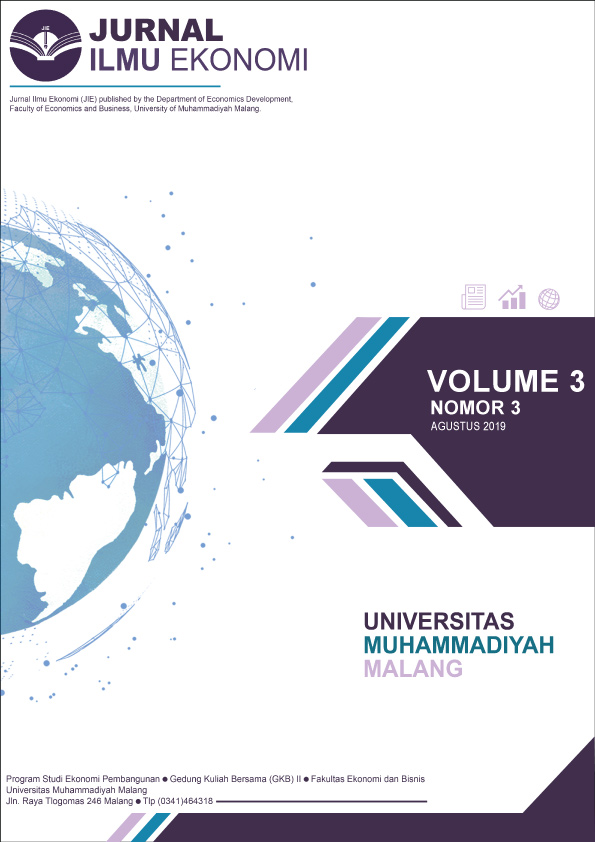ANALISIS INVESTASI ASING LANGSUNG (FDI) DI NEGARA ASEAN TAHUN 2000-2017
DOI:
https://doi.org/10.22219/jie.v3i3.9036Abstract
The aim of this research is nalyze foreign direct investment (FDI) from 2000 to 2017. The analytical tool used was multiple linear regression with panel data method by testing hypotheses namely F test, t-test, and Determination Coefficient R2. The software used in the analysis of this study was Eviews 9. The finding of the study denotes that all of influence of GDP growth, Trade Openness, Interest Rate and Inflation gave influence toward on Foreign Direct Invesment with a probability value of 0,0000. While individually, The country of Myanmar has the highest intercept inversely proportional to Malaysia which has the smallest intercept. While individually GDP growth and Trade Openness has a positive and significant effect on Foreugn Direct Invesment, Interest Rate and inflation has a negative and significant effect on Forign Direct Invesment.
Downloads
References
Abdullah, M. F. (2010) ‘Biaya Produksi Terhadap Profit Margin Pada Perusahaan Food and Beverages’, Jurnal Ekonomi Pembangunan, 8(1).
Abdullah, M. F. (2013) Dasar-dasar Manajement Keuangan. Malang: UMM Press.
Agénor, P. (2003) ‘Benefits and Co sts of International Financial Integration: Theory and Facts’, The World Economy, 26(8), pp. 1089–1118. doi: 10.1111/1467-9701.00564.
Anwar, C. J., Kuswantoro and Franscisca Dewi, S. (2016) ‘Faktor-Faktor Yang Mempengaruhi Foreign Direct Investment (Fdi) Di Kawasan Asia Tenggara’, Media Trend, 11(2), p. 175. doi: 10.21107/mediatrend.v11i2.1621.
Dewi, E., Amar, S. and Sofyan, E. (2013) ‘Jurnal Kajian Ekonomi, Januari 2013, Vol. I, No. 02 ANALISIS PERTUMBUHAN EKONOMI, INVESTASI, DAN KONSUMSI DI INDONESIA Oleh : Dewi Ernita ∗ , Syamsul Amar ∗∗ , Efrizal Syofyan ∗∗∗’, I(02), pp. 176–193.
Eko, N., Mukhammad, F. and Mawardi, K. (2018) ‘Analisis Determinan Foreign Direct Investment Di Negara Emerging Market Asia Periode 2011-2015’, Jurnal Administrasi Bisnis (JAB)|Vol, 57(2).
Elizabeth Asiedu (2002) ‘On the determinants of Foreign Direct Investments to Developing Countries: Is Africa Different?’, World Development, 30(1), pp. 107–119. Available at: https://pdfs.semanticscholar.org/cd41/7eb33b5747c231fac0a5e36d05eca0840809.pdf.
Habibi, A. and Hidayat R, W. (2017) ‘Analisis Pengaruh Economic Freedom Terhadap Foreign Direct Invesment Di Negara ASEAN’, Ekonomi Pembangungan, 8(1), p. 87.
Hoang, H. H. (2012) ‘Foreign Direct Investment in Southeast Asia: Determinants and Spatial Distribution’, Depocen, 30, pp. 1–24.
Moosa, I. A. (2009) ‘The determinants of foreign direct investment in MENA countries: An extreme bounds analysis’, Applied Economics Letters, 16(15), pp. 1559–1563. doi: 10.1080/13504850701578819.
Ningsih, D. and Zuhroh, I. (2009) ‘Analisis Permintaan Kredit Investasi Pada Bank Swasta Nasional Di Jawa Timur’, Jurnal Ekonomi Pembangunan, 9(2), p. 345. doi: 10.22219/jep.v8i2.3608.
Ruth, A. M. and Syofyan, S. (2014) ‘Faktor Penentu Foreign Direct Investment Di Asean-7; Analisis Data Panel, 2000-2012’, Media Ekonomi, 22(1), p. 97. doi: 10.25105/me.v22i1.2819.
Sukirno, S. (2005) Pengantar Teori Ekonomi Makro. jakarta: PT. RajaGrafindo Persada.
Sulistiowati, A. E. (2010) ‘Model Dinamis Investasi Di Indonesia Periode Tahun 2004-2007’, Jurnal Ekonomi Pembangunan, 8(1), p. 273. doi: 10.22219/jep.v8i1.3602.
Wahyudi suliswanto, muhammad sri (2016) ‘Tingkat Keterbukaan Ekonomi Di Negara Asean-5’, Neo-Bis, 10(1), pp. 33–48. doi: 10.21107/nbs.v10i1.1582.g1366.
Zaenuddin, M. (2012) ‘Analisis Faktor-Faktor Yang Mempengaruhi Investasi Pma Di Batam’, JEJAK: Jurnal Ekonomi dan Kebijakan, 2(2), pp. 156–166. doi: 10.15294/jejak.v2i2.1468.
Downloads
Published
How to Cite
Issue
Section
License
Copyright (c) 2019 Jurnal Ilmu EKonomi JIE

This work is licensed under a Creative Commons Attribution-ShareAlike 4.0 International License.
Authors who publish with this journal agree to the following terms:
- For all articles published in the JIE (Jurnal Ilmu Ekonomi), copyright is retained by the authors. Authors give permission to the publisher to announce the work with conditions. When the manuscript is accepted for publication, the authors agree to the automatic transfer of non-exclusive publishing rights to the publisher.
- Authors retain copyright and grant the journal right of first publication with the work simultaneously licensed under a Creative Commons Attribution-NonCommercial-ShareAlike 4.0 International License that allows others to share the work with an acknowledgement of the work's authorship and initial publication in this journal.
- Authors are able to enter into separate, additional contractual arrangements for the non-exclusive distribution of the journal's published version of the work (e.g., post it to an institutional repository or publish it in a book), with an acknowledgement of its initial publication in this journal.
- Authors are permitted and encouraged to post their work online (e.g., in institutional repositories or on their website) prior to and during the submission process, as it can lead to productive exchanges, as well as earlier and greater citation of published work (See The Effect of Open Access).
This is an open access article and licensed under a Creative Commons Attribution-NonCommercial-ShareAlike 4.0 International License








